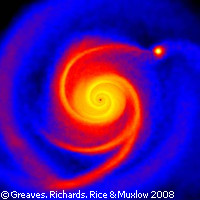UK astronomers discover youngest-ever planet
A planet that could be as young as 1,600 years has been discovered by UK astronomers. The images captured provide a unique view of planet formation in action, and the first picture of a protoplanet still embedded in its birth material. Using the Very Large Array (VLA) of radio telescopes in the US, astronomers led by Jane Greaves of the University of St Andrews in the UK studied the ball of gas and rocky particles around the star HL Tau. The star, which is estimated to be less than 100,000 years old, is located in the direction of the constellation of Taurus, 520 light years away. Inside the ball, they detected a bright 'clump', estimated to be about 14 times the mass of Jupiter and about twice as far from its mother star as Neptune is from the Sun. 'We see a distinct orbiting ball of gas and dust, which is exactly how a very young protoplanet should look. In the future, we would expect this to condense out into a gas giant planet like a massive version of Jupiter,' says Dr Greaves. Short emission wavelengths were specifically chosen at the VLA installation that would allow the scientists to search for rock particles about the size of pebbles. The presence of these pebbles are thought to indicate that rocky material is clumping together to form planets. Meanwhile, at the Merlin array of radio telescopes in the UK, the scientists used longer wavelengths to confirm that the emissions were from rocks, and not other sources such as hot gas. Many astronomers believe protoplanets are formed when a solid core forms first and then accretes a gaseous envelope. But computer simulations have revealed that a gravitational instability in the ball of dust and gas around the star, which allows small amounts of soft gas and rock to separate and cool down, was how the protoplanet came about. 'This instability mechanism has been controversial, but the simulated and real data are such a good match that it seems the mechanism really does operate in nature,' reads the statement from the Royal Society of Astronomers. The scientists believe that the new planet is the youngest planet object ever seen, being no more than 100,000 years old. There is even the suggestion that it could have formed as early as 1,600 years ago. At this time, XZ Tau, another young star in the same region, may have passed by HL Tau and 'tweaked' the disc of gas and rock, helping it to become unstable. Whether the proto-planet formed in only the last few hundred years, or sometime in the 100,000 years since the birth of HL Tau, the images provide a unique view of planet formation in action, and the first picture of a protoplanet still embedded in its birth material, say the scientists.
Countries
United Kingdom



